Ancient Queens Who Shaped an Asian Empire: Indradevi and Jayarajadevi
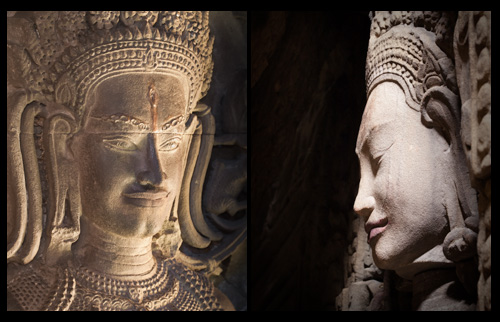
The Khmer civilization brought education, health, spirituality and enlightenment to the masses of 12th century Southeast Asia. Two women, both queens of King Jayavarman VII, played critical roles in the kingdom’s expansion and success.
By Phalika Ngin – © 2010 Copyright Phalika Ngin
Download a PDF of this article (650k)
ANGKOR, CAMBODIA — The temple of Angkor Wat may be Cambodia’s most well-known landmark but the prolific King Jayavarman VII built hundreds of stone monuments, including the complex shrines of the Bayon, Ta Prohm, Angkor Thom, Preah Khan, and Banteay Chhmar.
Fascination with this king’s architectural creations and territorial conquests has justifiably attracted much attention. New research now suggests that two brilliant advisers helped this king change the course of history. The king’s talented co-architects in shaping the Khmer Empire were none other than his two wives, Queen Indradevi and Queen Jayarajadevi.

Together, this royal trio made some of the most important contributions to Khmer heritage:
First, they built unique temples throughout Southeast Asia; Buddhist monuments and public structures that to this day bless Cambodia with cultural heritage that attracts millions of interested tourists from around the world.
Second, the enlightened trio implemented social systems in the 12th century that we still strive for today. While Europe was in the Dark Ages, these rulers gave their subjects — men and women alike — the right to education, property ownership, political power and public healthcare. While most contemporary social programs come into existence through the struggles or revolutions of the people these changes came from the royals themselves.
Many of their social programs are well-documented by archaeological analysis of public infrastructure built during Jayavarman VII’s reign, including roadways, bridges, small temples, rest stops and hospitals. Little, however, was known about the efforts spearheaded by the two queens to grant and raise women powers to divine heights at that time.
Images that appear to be royal portraits of the two queens reveal additional evidence of female power and participation within the government. Additional evidence from illustrated bas-reliefs, monument pediments and written inscriptions on steles offers insights that document the pro-active approach these women took as unsung pioneers of social values and women’s rights.
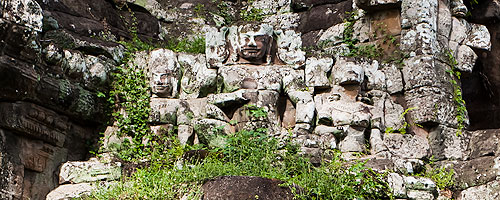
Public Health Care and Education in Ancient Cambodia
The reign of Jayavarman VII saw 102 new hospitals built throughout the kingdom. In her 1976 book, Angkor Un Peuple-Un Art, Madeleine Giteau, former director of the National Museum of Cambodia, documents royal dedications from steles at hospital sites that spell out the open door policy to all four castes. For instance, the stele of Say-fong outlines the administration staff of 98 members, their duties, their pay and the inventory of the hospital’s pharmacy.
While Hindu civilizations often limit education to men only — and elite men at that — Jayavarman VII’s monasteries were open schools and training centers that welcomed men and women, girls and boys, alike. In two illustrations in the Bayon, it appears that Queen Indradevi and Queen Jayarajadevi are portrayed as professors teaching groups of students (see photo below). While my evidence strongly suggests that these images are the queens themselves, the idea of female professors is revolutionary in and of itself.
To perpetuate these social systems, the inscriptions encouraged future kings and aristocrats to follow their charitable example of supporting public works by promising merit and heavenly rewards.
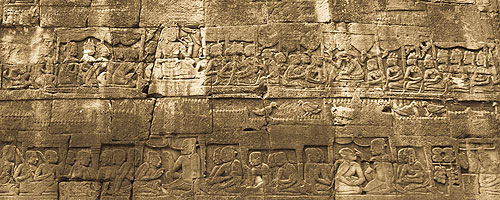
These important Khmer beliefs were not only expressed on steles, as previously thought. Every visitor to the Bayon, Angkor Thom and Banteay Chhmar, to cite three examples, sees illustrated stories that communicated these ideals to the illiterate, disparate population. These permanent carved illustrations appear in bas-relief and on monument pediments.
Clear Public Respect for King and Queens
On the second floor’s inner gallery bas reliefs of the Bayon, the lifestyle of this enterprising royal trio appears to be illustrated with details about their familial, social, political, and civil activities. The two queens most frequently appear sitting directly behind the king, tending to affairs of state in their palaces.
In a bas-relief depicting their romantic and personal lives, the king followed the lead of Queen Jayarajadevi (see photo below). On exterior reliefs at the Bayon, the two queens followed the king’s processions. In one particular bas-relief, one queen sits before the king, with both figures praying for the safety of their soldiers and victory in an upcoming battle.
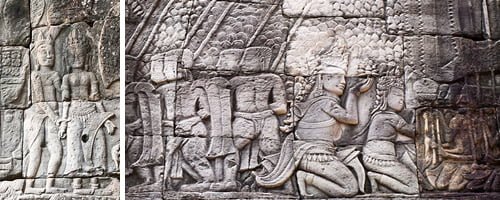
Seeing a queen sitting before this great Khmer conqueror (above right) implies that Jayavarman VII recognized Indradevi as a worthy military strategist. Many bas-relief depictions emphasize the important roles the two queens played in Jayavarman VII’s life. The implication is that this great Khmer king could not have realized his ambitions without Queen Indradevi and Queen Jayarajadevi by his side, organizing and managing his vast empire. Together they formed a royal trinity that changed the world from their capital of Angkor Thom, a metropolis of one million inhabitants in the 12th century.
The Dynamic Power of the Royal Trinity
Observing this dynamic, active profile of the royal trio challenges many historical stereotypes that cast Jayavarman VII and his queens as placid, aging ascetics. Some historians portray them as devout Buddhists absorbed by meditation in search of enlightenment. Based on my research, this misinterpretation appears to confuse passive Theravada Buddhism with the active Mahayana Buddhism that they practiced. The Mahayana Buddhist dharma called upon these three royals not only to enlighten themselves, but to actively take its message to the entire population.
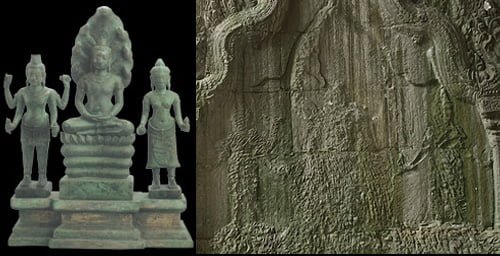
The royal trinity’s brand of Mahayana Buddhism was infused with respect for women through the goddess Prajnaparamita, the Mother of all Buddhas. The trinity included the Lord Buddha; Lord Avalokiteshvara, the compassion of all Buddhas; and the goddess Prajnaparamita, the perfection of transcendent wisdom. During their reign, the empowerment of this trimurti or trinity, was represented in bronze statues (above) and extensively carved on the royal trio’s monuments (below).
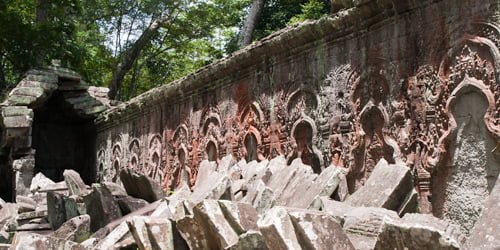
Particularly in the Rajavihara, the royal monastery, now known as Ta Prohm, this trinity was carved every two meters in the inner galleries. During the iconoclasm that followed Jayavarman VII’s reign Hindu successors painstakingly chiseled out thousands of royal Mahayana trinities from the walls (see photo above). In Ta Som, Shivaists removed pediments featuring Avalokiteshvara at the main temple entries along with the entire façades. On pediments, where the king and the queen worshiped Prajnaparamita, the images of the Prajnaparamita and the royals were later defaced, and then, demolished. (see photos below).
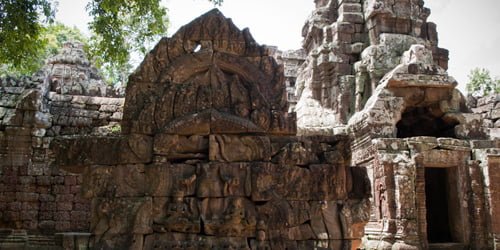
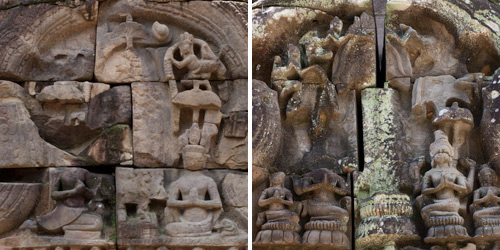
Enduring Evidence of Enlightened Rulers
Despite attempts to destroy their legacy, the royal trinity left a clear record of their beliefs for the ages. Throughout the empire the royals repeated their messages, consistently using religious iconography showing respect for women, with Prajnaparamita, a female Mahayana Buddhist divinity, standing on equal footing with Lord Avalokiteshvara. This hierarchy is unseen in prior eras yet, here, as Buddhism supplanted Shivaism, the roles of women were raised to divine heights. Here, the dominant forces became subservient to ideals of equality that infuriated them.
In the end, Shivaism briefly dominated the country one last time, desperate to show that it had no place for the importance of women either in religious or civil representations. Enraged Shivites proceeded to obliterate all the representations of Prajnaparamita that they had the energy to destroy (See above). Despite their misguided efforts the message survived.
All visitors to the great walled city of Angkor Thom still receive additional confirmation of this ideology. For more than 800 years, every visitor has had to enter and exit through one of five gateways into the Angkorian city-fortress that the royal trio built. At each gate, they created clear and subtle messages of their spiritual and personal beliefs.
As one approaches the gates, one sees three giant faces of the king forming three distinct peaks (see photo below), resembling the tri-conical crowns that Jayavarman VII wore to military functions, his branded signature, logo, and symbol of the king’s personal trinity – Queen Indradevi, Jayavarman VII and Queen Jayarajadevi. This formidable royal trio had shared visions; by combining their feminine and masculine forces and intelligence they achieved milestones of social evolution by giving equal rights and opportunities to pave the road to a civilized nation.
As mentioned above, enemies of this philosophy tried to obliterate these enlightened views, demolishing the façades of each gateway that, in my theory, previously showed the royal trinity. Following the obliteration of Buddhist symbols they renamed the faces to represent the Hindu god Shiva (or Brahma) (see below). But enough evidence still remains to see the original intent, especially when taken in context with the rest of the iconography of this reign.
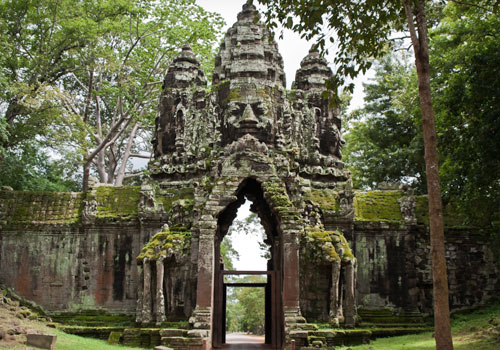
At ground level on both sides of each gate appear the special three-headed elephants of Indra, the Hindu God of Gods. Here, the king fitted the symbolic elephants with three conic crowns of lotus petals. This subtle but powerful change implied to all that these were no longer Indra’s elephants, but Jayavarman VII’s royal elephants. The king was proudly accompanied by his two queens smiling always, one on each side of him. All three royal benefactors sat astride the elephants welcoming every visitor (see below).
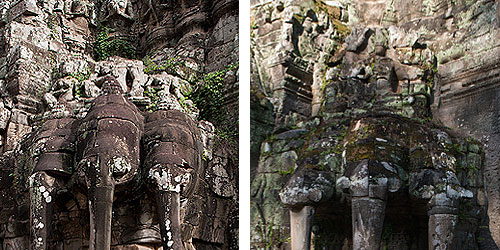
Above the king and the two queens, seven devata (sacred females in Khmer iconography) with both hands joined at heart level in the anjali prayer gesture greet and bless all visitors. Above, on both sides of the king’s giant face, a special devata appears draping two long flower garlands from her waist down, one by each side of his ear (see below). The concept of the trinity — two queens and one king — is frequently seen. Each city visitor therefore learned the personal, spiritual, and civil beliefs of its rulers, with clear messages regarding the rights and importance of women in this kingdom.
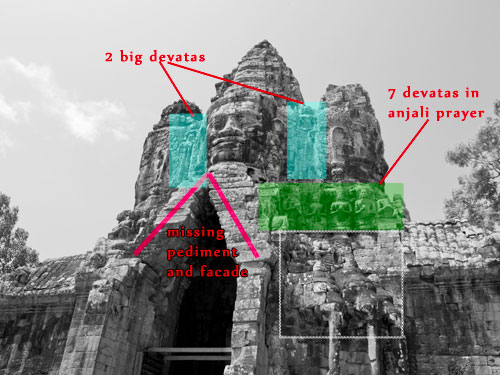
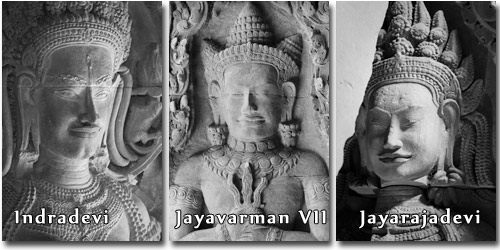
The time has come to understand this king and his two queens by the clear records they left for future generations. Their monuments, inscriptions and bas-relief illustrations show us magnanimous rulers who cared for their citizens.
These three great leaders shared a magnificent vision for their people. They worked together weaving wisdom, common sense, and humanitarian principles to create their own blend of Buddhism, a tripod of strength that embraced their national heritage, religious and civil ethics, and personal beliefs.
Like all true leaders, this royal trio led by example. Eight hundred years, later their legacy in stone still broadcasts their beliefs in humanity. While Angkor Wat impresses visitors with grandiose architecture the Bayon inspires visitors with heartfelt awe, beneath the king’s giant caring faces that peacefully smile upon them from above and surrounded by the queens’ gentle smiles at ground level. In the Bayon today, King Jayavarman VII, Queen Jayarajadevi and Queen Indradevi still bless us with smiles recognizing the humanity in all of us.
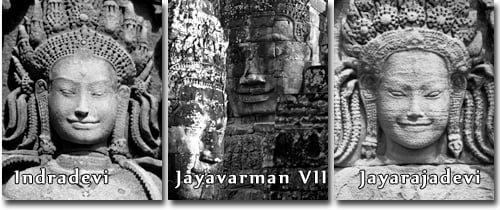
About the Author
 Phalika Ngin is a Khmer-American photographer and independent researcher living in Siem Reap, Cambodia. Her website, PhalikaN.com, presents her historical research, focuses on Neo-Classic Cambodian arts and crafts, and includes galleries of her original photography.
Phalika Ngin is a Khmer-American photographer and independent researcher living in Siem Reap, Cambodia. Her website, PhalikaN.com, presents her historical research, focuses on Neo-Classic Cambodian arts and crafts, and includes galleries of her original photography.
Cambodia Insight Magazine featured Ms Ngin’s research on Queen Indradevi and Queen Jayarajadevi in this cover article: “The Resurrection of Indradevi and Jayarajadevi-Queens of the 12th Century Khmer Kingdom“.
